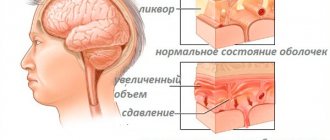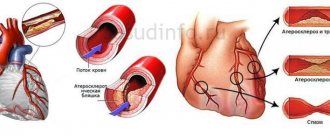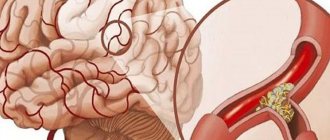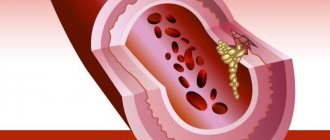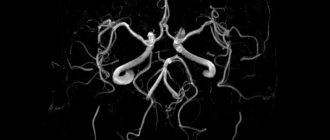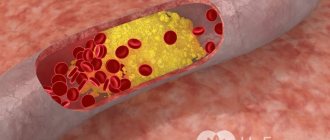Characteristics of the concept
In a healthy person, cerebrospinal fluid circulates in the intercerebral space of the brain, nourishing tissues and protecting them from damage. As a result of exposure to negative factors, the volume of spinal fluid increases, which causes serious disorders and complications. Manifestations of cerebral edema rapidly increase, and the patient’s condition deteriorates sharply.
Interesting fact! The disease was first described by N. Pirogov in 1865.
Swelling disrupts the permeability of the vascular walls, blocking the flow of blood into the surrounding tissue structures. As a result of the development of pathological processes, water molecules penetrate through the membrane into the nerve plexuses. There, cells interact with proteins, increasing in volume.
Cerebral edema cannot act as an independent disease; the pathology develops secondarily as a complication of other diseases. The disease threatens human life because cerebral structures are compressed as a result of an increase in their volume. The progression of the process leads to pinching of the brain structures that are responsible for thermoregulation, breathing, and cardiac activity.
Classification
Cerebral edema is characterized in detail by the international classification of diseases. This fact makes it easier to diagnose the pathology, which allows you to start treatment in a timely manner.
Note! It is necessary to distinguish between edema that develops as a result of various diseases and perifocal edema, when swelling of the brain occurs after injuries.
Edema is differentiated based on the etiology of the disorder:
- Vasogenic, caused by increased vascular permeability. The central and circulatory systems are separated by an anatomical barrier - the blood-brain barrier. Edema develops as exudate passes through the barrier. This leads to an increase in the volume of white matter. It develops as a result of internal hemorrhage, damage to the central nervous system, and the occurrence of neoplasms.
- Hydrostatic. Formed when ventricular pressure increases. Mostly diagnosed in infants. In adults, traumatic brain injuries are rarely detected after surgical interventions, when wedging of bone parts into the medulla is detected.
- Cytotoxic. It is formed due to intoxication of brain cells as a result of radiation, poisoning, and also after strokes. Tissue metabolism is disrupted. Cell death can be stopped in the first hours of pathology progression, after which the process becomes irreversible.
- Osmotic. Brain fluid includes tiny dissolved particles, the concentration of which per kilogram of cerebrospinal fluid is called osmolarity. If there is an imbalance in the ratio of particles and brain plasma, edema develops. As a result of the increase in the number of particles in the exudate, tissues attempt to reduce their volume by absorbing moisture from the plasma. Such an imbalance occurs due to water effects on the brain, hyperglycemia, and encephalopathy.
A separate category is cerebral edema in newborns, which appears as a result of intrauterine hypoxia, improper development of the embryo, and injuries received during delivery.
Depending on the parameters of brain damage, local, diffuse and generalized edema are distinguished. A local type of dislocation is recorded in the lesion, diffuse - in one hemisphere, generalized - in both hemispheres.
Based on the cause of its appearance, edema can be toxic, traumatic, hypertensive, ischemic, postoperative, tumor, or inflammatory.
Swelling may affect the cerebral vessels, substance or brain stem. The latter condition is the most dangerous because it is accompanied by impaired breathing and blood supply.
Symptoms
Despite the causes and consequences of cerebral edema, in any case, the clinical picture of the disease will include focal and general cerebral symptoms. The order in which signs of pathology appear will depend on the underlying causes of hemorrhage. The form of the disease can be lightning fast (immediate help is required, there is a real struggle for the patient’s survival, the probability of death is high) and gradual (there is a short time period that allows you to easily prevent the death of the patient).
The main symptoms of edematous type cerebral hematoma include:
- Darkness of consciousness. This symptom will manifest itself in any case, regardless of the cause of the disease. Clouding of consciousness can be expressed in different ways: seizures of epilepsy, congestion, stupor, coma, clouding of consciousness, fainting. The development of swelling will always be accompanied by an increase in the depth of a person’s fainting state.
- Pain in the head. Headaches as a result of the development of edema are observed only in those patients who have a history of an acute form of some kind of brain pathology.
- Symptoms of meningitis. With the development of inflammation, tumor, and edema in the brain structures, meningeal symptoms often appear. Their presence in elderly patients should be alarming, because such symptoms are extremely dangerous for them.
- Focal symptoms. Typically, signs of this type are recorded at the stage of development of swelling. The patient may have impaired movement of the limbs, and paralysis of half the torso and face may develop. Problems with the functioning of the visual and speech centers, visual and audio hallucinations, and difficulties with coordination of movements are also often observed. Traditionally, cerebral edema, which leads to loss of consciousness in patients, leads to the inability to conduct higher nervous activity.
- Cramps. As the area of swelling increases, brief cramps may occur that last only a few minutes. The highest degree of this symptom is the development of muscle atony.
- Decreased blood pressure, unstable pulse. Dangerous symptoms, which clearly indicate that the edema spreads to the trunk, where the main central nervous system centers responsible for the vital functions of the body are located.
The consequences of cerebral edema will directly depend on the therapeutic effect, the form of pathology, the age of the patient and a number of other factors. Moreover, it is extremely difficult to eliminate edema completely (this is only possible in young patients). Most often, swelling cannot be completely removed, so the consequence of the disease is disability.
What Causes Brain Swelling
Brain tissue swells due to infectious or traumatic causes.
Traumatic brain injuries
Injuries, wounds with wedging of the cranial parts, concussions block the evacuation of fluid, causing the progress of necrotic processes. Traumatic swelling is complicated by soft tissue damage. This leads to problems with movement, seizures, and paralysis of the legs.
This group includes swelling that occurs as a result of operations and craniotomy. After surgery, a scar often forms in the head area, which impedes the circulation of fluid.
Infectious diseases
Brain edema occurs as a result of an acute inflammatory phenomenon. The pathological symptom develops against the background of meningitis, encephalitis, and toxoplasmosis. When purulent inclusions form, the person’s condition deteriorates sharply.
Tumor neoplasms
Cancerous tumors put pressure on soft tissues, causing irritation and swelling of the structures. After eliminating the formation, the swelling quickly subsides. The patient requires long-term rehabilitation treatment.
Hemorrhage
Rupture of arterial walls occurs as a result of the presence of atherosclerotic plaques, aneurysms, and head trauma. This condition has a high mortality rate.
Stroke
Coronary heart disease occurs as a result of the formation of a blood clot in an artery. This provokes acute oxygen deficiency and tissue necrosis. The death of cellular structures causes swelling.
Causes of cerebral edema
The most common causes of OGM are:
- severe traumatic brain injury (basal skull fracture, brain contusion, subdural or intracerebral hematoma;
- ischemic or hemorrhagic stroke;
- hemorrhage into the ventricles or subarachnoid space;
- brain tumors (primary and metastatic);
- some infectious and inflammatory diseases (meningitis, encephalitis);
- subdural empyema.
Much less frequently, the occurrence of OGM is caused by:
- severe systemic allergic reactions (anaphylactic shock, angioedema);
- anasarca caused by renal or heart failure;
- acute infectious diseases (mumps, measles, influenza, scarlet fever, toxoplasmosis);
- endogenous intoxications (liver or kidney failure, severe diabetes mellitus);
- acute poisoning with medications or poisons.
In older people who abuse alcohol, there is an increase in the permeability of the vascular walls, which can lead to the development of cerebral edema.
The causes of OGM in newborns are the following factors:
- severe gestosis;
- umbilical cord entanglement;
- intracranial birth injury;
- protracted labor.
In rare cases, OGM is observed in completely healthy people. For example, if a person climbs high into the mountains without the necessary stops to acclimatize the body, he may develop cerebral edema, which doctors call mountain edema.
Signs and stages of pathology
The progression of swelling is characterized by 3 stages: initial, severe, outcome:
- The first stage is expressed in repeated convulsions and disruption of the conscious sphere.
- With a severe course of the disease, a cerebral coma occurs, accompanied by increased convulsive syndrome and signs of damage to the brain stem: strabismus, increased breathing.
- The third stage is difficult, causing irreversible consequences in the form of mental retardation, and death is often diagnosed.
The dominant symptom of cerebral edema in adults is confusion. As the manifestations increase, the person loses consciousness and then falls into a coma. As the disease progresses, convulsive attacks become more frequent, alternating with muscle atony.
As swelling progresses along with acute or chronic cerebral disease, consciousness initially remains. In this case, signs of cerebral edema include visual disturbances, excruciating pain in the head, problems with movement, vomiting, and hallucinations.
Dangerous symptoms indicating compression of the brain stem include deep breathing, hypotension, and a sharp increase in body temperature. The appearance of strabismus indicates the separation of the subcortical layer from the cerebral cortex.
Dangers of Edema
Delayed diagnosis and improper treatment can lead to severe disturbances in the vital functions of breathing and heartbeat. Which lead to death. Severe, permanent neurological damage may occur, such as a violation of the motor and sensory activity of the limbs.
Timely provision of assistance will allow you to avoid these violations. In order to quickly receive qualified help, you need to know the symptoms of this condition.
Symptoms and manifestations
Signs of cerebral edema are conventionally divided into several groups.
- Symptoms of increasing intracranial pressure;
- Neurological manifestations;
- Symptoms of growing swelling of brain cell formations and their infringement.
Symptoms of increasing intracranial pressure are manifested by the following signs:
- Increasing headache with a feeling of fullness;
- Signs of lethargy and drowsiness appear;
- In the midst of complete rest, vomiting appears;
- The development of intracranial hypertension leads to impaired eye movement, and vision periodically deteriorates.
Neurological symptoms begin to develop due to the spread of edema to the cortex, then to the subcortical formations. The pressure inside increases, this leads to the following disorders.
- Impaired grasping and defensive reflexes. Pathological reflexes appear that are characteristic only of newborns, etc.
- Attacks of convulsions followed by psychomotor agitation.
- The spasms increase and take over the entire body.
When swelling grows and treatment has not yet begun, severe irreversible damage to the nervous tissue occurs.
- Disturbances in the centers of breathing and heartbeat, resulting in death;
- Unilateral severe neurological damage, due to compression of the medulla on one side. One eyeball is dilated, loss of reflexes, paralysis of the limbs on one side.
- Temperatures rise to 40C and above. She can't be shot down.
- The patient becomes seriously ill - coma.
Coma due to cerebral edema
Coma is characterized by a state of deep pathological sleep. The functioning of the nervous system slows down and is disrupted. A person is unconscious and does not respond to external stimuli or pain. Vital functions are impaired.
Staying in a coma for a long time leads to the death of many nerve cells, resulting in death.
Features of cerebral edema in a newborn
The peculiarity of brain swelling in adults is that it most often increases more slowly than in children. The development of edema in a newborn occurs very quickly and requires thorough knowledge of emergency care, skills in diagnosis and treatment. Most often in children, swelling of the brain stem occurs.
Swelling of nerve tissue in newborns occurs due to several reasons.
- Birth injuries are the most common and common cause of swelling.
- Toxic lesions of the fetus;
- Genetic disorders.
With adequate timely therapy, the nerve cells are restored and the swelling subsides. Severe course entails various consequences, including:
- Delayed growth and general development of the child;
- Epileptic seizures;
- Paralysis;
- Dropsy of the medulla;
- GVA.
Swelling during stroke
The consequence of an ischemic or hemorrhagic stroke is cerebral swelling. Impaired blood circulation in the ischemic form is accompanied by blockage of the vessel, which leads to a lack of oxygen and necrosis of brain tissue. In the hemorrhagic form, the hemorrhage is localized under the meninges. This leads to a sharp increase in intracranial pressure and swelling.
Initially, swelling is associated with metabolic disorders at the site of the lesion and is located in the brain. After 6 hours, a vasogenic type of edema develops, which is localized in the white matter. A similar phenomenon occurs due to the penetration of cerebrospinal fluid and vascular proteins into the extracellular space. Tissues begin to die, causing fluid to accumulate in the capillaries.
Cerebral edema during a stroke appears rapidly; it is localized in any part of the brain matter. Relatives of the victim are required to notice unhealthy manifestations in time and immediately seek medical help.
How can fluid accumulation in brain tissue manifest itself?
Probably the most typical, although far from specific, symptom characterizing the degree of fluid accumulation in the brain is a severe headache, which is often not relieved by almost any analgesics (and if they are relieved, it is only for a short time). Such a symptom should especially seem suspicious if there has been a recent traumatic brain injury and the headache is accompanied by nausea and vomiting (also typical signs of TBI).
Thus, the symptoms of AGM are easy to recognize, especially if there were prerequisites for this (see above):
- Intense headache, dizziness, nausea, vomiting;
- Absent-mindedness, impaired attention, inability to concentrate, forgetfulness, decreased communicative (individual) abilities to perceive information;
- Sleep disturbance (insomnia or drowsiness);
- Fatigue, decreased physical activity, constant desire to lie down and abstract from the world around you;
- Depression, state of depression (“the world is not nice”);
- Visual impairment (squint, floating eyeballs), orientation disorder in space and time;
- Uncertainty in movements, changes in gait;
- Difficulty speaking and communicating;
- Paralysis and paresis of the limbs;
- The appearance of meningeal signs;
- Reduced blood pressure;
- Heart rhythm disturbances;
- Convulsions are possible;
- In especially severe cases - clouding of consciousness, respiratory and cardiac dysfunction, coma.
If the brain is swollen and there is no proper treatment, the patient can expect the most tragic consequences - the patient may fall into a stupor, and then into a coma, where there is a very high probability of respiratory arrest and, consequently, the death of a person as a result of this.
It should be noted that in each period of progression of increased intracranial pressure (development of intracranial hypertension), a certain protective mechanism is activated. The capabilities of the complex of compensatory mechanisms are determined by the ability to adapt under conditions of fluid accumulation in the craniospinal system and an increase in brain volume.
Diagnosis and determination of the causes of edema and swelling of the brain, as well as the degree of danger for the patient, is carried out using a neurological examination, biochemical blood tests and instrumental methods (basically, all hopes are for magnetic resonance or computed tomography and laboratory).
Edema in children
The disease is often diagnosed in infants due to birth trauma. The accumulation of fluid leads to increased intracranial pressure and the development of cerebral edema. Other causes of pathology include late gestosis, intrauterine infection, brain diseases, and hypoxia.
Increased intracranial pressure in newborns leads to pinching of the medulla oblongata, which is responsible for breathing and thermoregulation. The child begins to cry, burp frequently, the temperature rises, and convulsive seizures appear. The fontanelle begins to protrude. The pathological condition often causes the sudden death of a child.
The outcome of therapy depends on the parameters of the affected area and the timeliness of treatment. The disease in infants occurs differently, since the child’s body is not able to maintain vascular tone, regulate the circulation of cerebrospinal fluid and the level of intracranial pressure. The baby in this situation is saved by the presence of several fontanelles in the cranial bones. This physiological feature protects the baby from cerebral compression and swelling.
The consequences of cerebral edema in children can include:
- delayed psychophysical maturation;
- increased activity;
- epileptic seizures;
- hydrocephalus;
- vegetative-vascular dystonia;
- paralysis.
To prevent the development of complications, you need to urgently seek medical help.
Symptomatic manifestations of swelling
Typically, symptoms of acute edema in adults and children appear after the main signs of the underlying disease. They occur as swelling progresses and intracranial pressure increases. Before complications occur, the patient may experience:
- headaches, migraines, feeling of fullness in the head;
- anxiety;
Complete loss of vision is possible if the posterior cerebral artery is compressed. Possible signs of tendon loss and neck stiffness. The intensity of symptoms depends on the degree of swelling.
Nausea and vomiting usually result from increased blood pressure and migraines.
Symptoms may appear simultaneously or gradually. In severe cases, loss of consciousness and coma occurs. Cerebral edema and its consequences in such situations pose the greatest danger due to the uncertainty of the prognosis.
Diagnostics
The choice of diagnostic methods depends on the clinical picture of the pathology. Usually the patient is referred to undergo magnetic resonance imaging, which determines the location of the edema and the extent of its spread. The procedure allows you to make a prognosis regarding the development of complications.
Note! It is important to determine the localization of the pathological process: swelling in the left hemisphere reduces intellectual abilities, paralysis of one side of the body is possible.
The patient is prescribed a computed tomography scan and undergoes the necessary tests. When reading blood tests, the doctor reveals the degree of intoxication in the body. A puncture is also performed. Cerebrospinal fluid obtained during a diagnostic procedure is examined for the presence of infection and oncology.
How is the disease diagnosed?
If the patient is suspected of cerebral edema, then treatment of the disease cannot be carried out at home. The patient should immediately consult a doctor, where he will be prescribed a full examination and adequate treatment.
Based on the totality of characteristic signs and symptoms caused by the condition of swelling, as well as a number of medical examinations, the doctor prescribes medications and procedures.
Examinations that are prescribed if edema is suspected:
- Magnetic resonance imaging. The examination makes it possible to detect the location of the edema and its size. Helps predict the effects of swelling on the brain.
- Computer tomogram. The examination helps to identify the extent of damage to brain tissue and locate the location. With help, it is possible to make a preliminary forecast of possible complications.
- Blood analysis. Such an examination allows you to find out whether intoxication of the body has occurred.
- Puncture. The analysis is taken from the spine, the cerebrospinal fluid is examined to detect infections or cancer.
Treatment of the disease
In some cases, the manifestations of the disease are eliminated on their own: with a mild concussion or in climbers or scuba divers. In other cases, the situation of cerebral edema requires the adoption of emergency therapeutic measures.
Urgent Care
Until the ambulance arrives, you can maintain the victim’s condition by slowing down the spread of edema. To do this, it is necessary to ensure maximum flow of fresh air and cover the patient’s head with ice packs. It is necessary to constantly monitor the condition of the respiratory tract; it is necessary to clear the airways of vomit. To make breathing easier, it is recommended to turn your head to the side and place a cushion under your feet.
Basic therapy methods
Treatment is based on normalizing oxygen metabolism in brain cells. This requires a combination of drug and surgical therapy. The following medical procedures are performed on the patient:
- Oxygen therapy. Using special equipment, oxygen is injected into the patient's airways. This procedure improves brain nutrition, allowing for faster recovery.
- Infusion of drugs that normalize blood pressure, blood circulation, and eliminate infection.
- Hypothermia. Decrease in temperature, which suppresses swelling.
- Ventriculostomy. The procedure is aimed at removing excess fluid through a catheter. This lowers intracranial pressure.
- Taking glucocorticoids, which are especially effective for perifocal edema. For swelling due to tumor processes, Dexamethasone is prescribed.
- Use of diuretics. Diuretics evacuate excess fluid, which helps reduce cerebrospinal fluid pressure on the brain.
Note! Surgical intervention is required in severe cases of the pathology.
During the operation, the catalyst of the disease is eliminated. A decompensated craniotomy is performed, during which a certain section of the cranial bone is removed. This allows you to lower intracranial pressure. If there is a tumor wedging, it must be removed.
Alternative medicine
It is possible to reduce the progression of cerebral edema with the help of traditional medicine, but complete recovery occurs only after drug treatment.
When a tumor forms in the brain, a decoction of white mistletoe is prepared. It is necessary to boil a glass of milk along with 3 grams of dried raw materials. You should drink the medicinal drink for a week.
Propolis tincture is also effective. To prepare it, you need to mix 100 ml of alcohol with 10 grams of bee product. The product is infused for a week and taken 1 teaspoon before meals.
Treatment of cerebral edema
The founder of the Soviet school of neurosurgery N. N. Burdenko wrote: “He who masters the art of treating and preventing cerebral edema holds the key to the life and death of the patient.”
Patients with AGM are subject to emergency hospitalization in the intensive care unit. Treatment includes the following areas:
- Maintaining optimal blood pressure levels. It is desirable that the systolic pressure is not lower than 160 mmHg. Art.
- Timely tracheal intubation and transfer of the patient to artificial respiration. The indication for intubation is an increase in the intensity of respiratory failure. Mechanical ventilation is performed in hyperventilation mode, which increases the partial pressure of oxygen in the blood. Hyperoxygenation contributes to the narrowing of cerebral vessels and a decrease in their permeability.
- Facilitation of venous outflow. The patient is placed on the bed with the head end elevated, with the cervical spine maximally extended. Improving venous outflow contributes to a gradual decrease in intracranial pressure.
- Dehydration therapy. Aimed at removing excess fluid from cerebral tissues. It is carried out by intravenous administration of osmotic diuretics, colloid solutions, loop diuretics. If necessary, to potentiate the diuretic effect of diuretics and supply neurons with nutrients, the doctor may prescribe intravenous administration of a hypertonic glucose solution, 25% magnesium sulfate solution.
- Glucocorticoid hormones. Effective in cases of perifocal cerebral edema caused by the development of a tumor process. Ineffective in cases of acute brain injury associated with traumatic brain injury.
- Infusion therapy. Aimed at detoxification, elimination of disturbances in water-electrolyte and colloid-osmotic balance.
- Antihistamines. They reduce the permeability of vascular walls, prevent the occurrence of allergic reactions, and are also used to relieve them.
- Drugs that improve cerebral blood circulation. They improve blood flow in the microvasculature, thereby eliminating ischemia and hypoxia of nervous tissue.
- Metabolic regulating agents and nootropics. Improve metabolic processes in damaged neurons.
- Symptomatic therapy. Includes the prescription of antiemetics, anticonvulsants, and painkillers.
If AGM is caused by an infectious-inflammatory process, antiviral or antibacterial drugs are included in complex therapy. Surgical treatment is carried out to remove tumors, intracranial hematomas, and areas of brain crushing. For hydrocephalus, shunt surgery is performed. Surgery is usually performed after the patient's condition has stabilized.
In some cases, brain swelling requires surgery
Complications and prognosis
Therapy for cerebral swelling is based on preventing relapses and restoring the activity of the hemispheres and nerve plexuses. The prognosis of treatment depends on the severity of the pathology and the qualifications of the doctor. When therapy is started on time, the outcome is favorable.
At the initial stage, cerebral edema is completely curable; when the disease is detected at the last, third stage, the death of nerve fibers and destruction of the myelin sheath of neurons is recorded.
Note! Complete elimination of swelling without the development of complications is possible only in young people with a toxic form of the pathology.
Self-relief of painful symptoms is observed with mountain edema. In many cases, death is diagnosed from cerebral edema. Survivors experience residual effects in the form of headaches, decreased intellectual abilities, neurological disorders, and disability.
The functions of dead brain cells can be performed by nearby areas of the brain after a long period.
Therefore, it takes a long time for a person who has suffered a stroke to re-acquire speech and movement skills.
One of the common consequences of cerebral swelling is cerebral edema-swelling (CEBS). Symptoms of this complication in adults include vomiting, headaches, and hallucinatory syndrome. As ONGM progresses, a person falls into a comatose state, and death is often recorded.
